1997 BUICK REGAL oil change
[x] Cancel search: oil changePage 3 of 422

Supplement to the 1997 Buick Regal and Century Owner’s Manuals
This is a correction to information found on page 6-40 (Regal only) and page 6-38 (Century only).
Inflation -- Tire Pressure
The Tire-Loading Information label, which is on the inside of the trunk lid shows the correct inflation
pressures for pur tires when they’re cold. “Cold” means your vehicle has been sitting for at least three
hours or driven no more than
1 mile (1.6 km).
This is a correction to information found
on page 6-63 (Regal only).
Engine Crankcase
Oil and Filter Change . . . . . . . . . . . . 4.5 quarts (4.2 L)
97REGWENOOl
1
ProCarManuals.com
Page 147 of 422
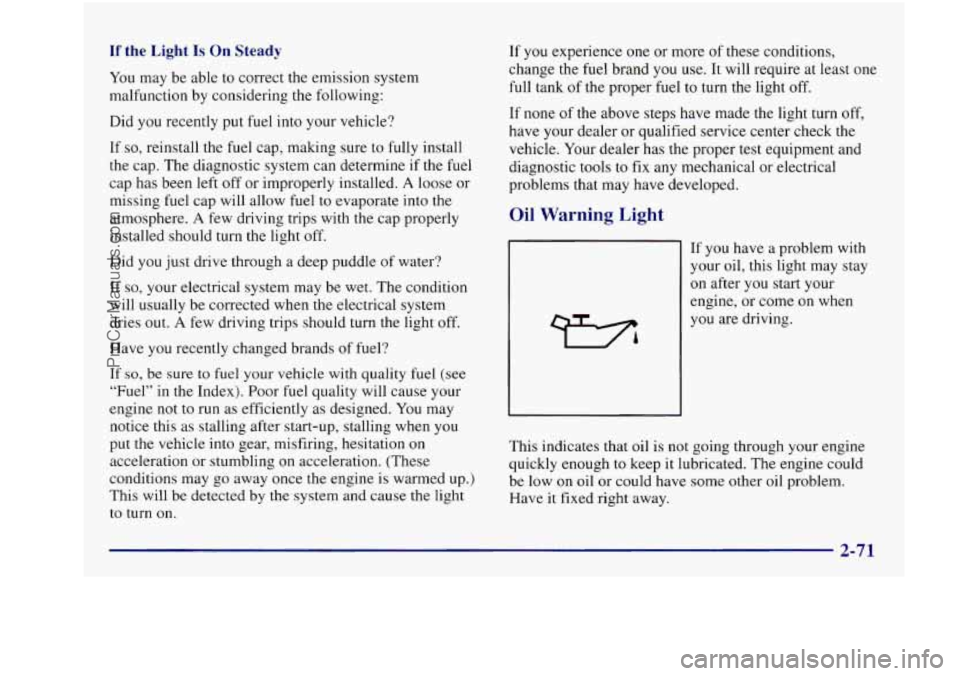
If the Light Is On Steady
You may be able to correct the emission system
malfunction by considering the following:
Did you recently
put fuel into your vehicle?
If
so, reinstall the fuel cap, making sure to fully install
the cap. The diagnostic system can determine
if the fuel
cap has been left
off or improperly installed. A loose or
missing fuel cap will allow fuel to evaporate into the
atmosphere.
A few driving trips with the cap properly
installed should turn
the light off.
Did you just drive through a deep puddle of water?
If
so, your electrical system may be wet. The condition
will usually be corrected when the electrical system
dries out.
A few driving trips should turn the light off.
Have you recently changed brands of fuel?
If
so, be sure to fuel your vehicle with quality fuel (see
“Fuel” in the Index). Poor fuel quality will cause your
engine not to run as efficiently as designed. You may
notice this as stalling after start-up, stalling when you
put the vehicle into gear, misfiring, hesitation on
acceleration or stumbling on acceleration. (These
conditions may go away once the engine is warmed up.)
This will be detected by the system and cause the light
to
turn on. If you
experience one or more of these conditions,
change the
fuel brand you use. It will require at least one
full tank of the proper fuel to turn the light off.
If none of the above steps have made the light turn off,
have your dealer or qualified service center check the vehicle. Your dealer has the proper test equipment and
diagnostic tools
to fix any mechanical or electrical
problems that may have developed.
Oil Warning Light
If you have a problem with
your oil, this light may stay
on after you start your
engine,
or come on when
you are driving.
This indicates that oil is not going through your engine
quickly enough to keep it lubricated. The engine could
be low on oil or could have some other oil problem.
Have it fixed right away.
2-71
ProCarManuals.com
Page 149 of 422
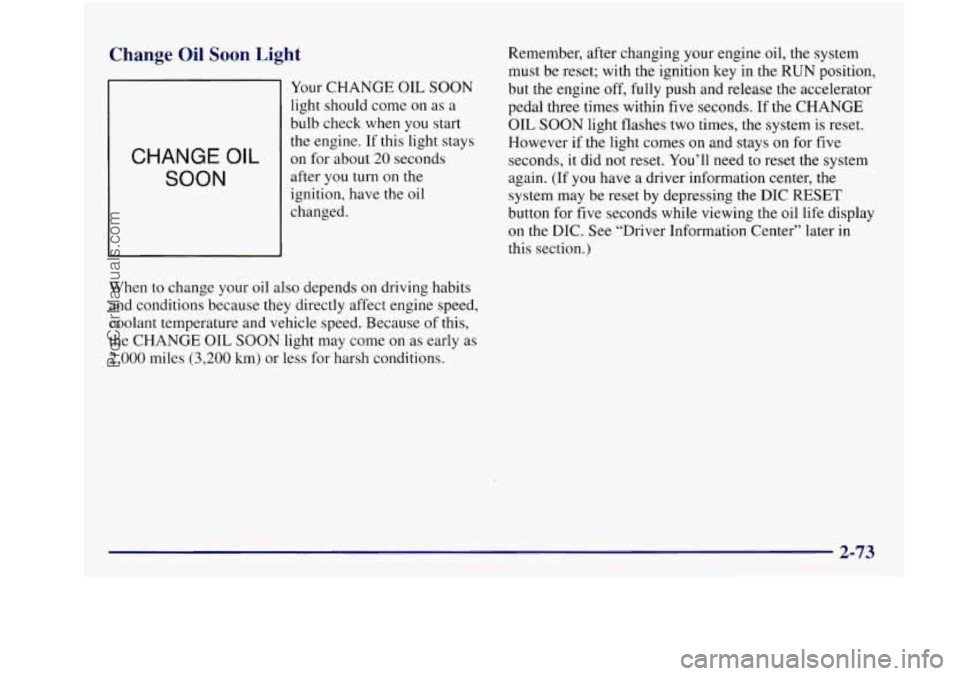
Change Oil Soon Light
CHANGE OIL
SOON
Your CHANGE OIL SOON
light should come on as a
bulb check when you start
the engine. If this light stays
on for about 20 seconds
afte.r you turn
on the
ignition, have the oil
changed.
When to change your oil also depends
on driving habits
and conditions because they directly affect engine speed,
coolant temperature and vehicle speed. Because
of this,
the CHANGE OIL SOON light may come on as early as
2,000 miles (3,200 km) or less for harsh conditions. Remember,
after changing your engine
oil, the system
must be reset; with the ignition key in the
RUN position,
but the engine off,
fully push and release the accelerator
pedal three times within five seconds.
If the CHANGE
OIL SOON light flashes two times, the system is reset.
However if the light comes on and stays on for five
seconds, it did not reset. You’ll need to reset the system
again. (If you have a driver information center, the
system may be reset
by depressing the DIC RESET
button for five seconds while viewing the oil life display
on the DIC. See “Driver Information Center” later in
this section.)
ProCarManuals.com
Page 155 of 422

OIL LIFE MONITOR: Shows an estimate of the oil’s RANGE: Shows the approximate distance you can
remaining useful life. When the oil life index is less than drive without refueling. This is based on the amount
of
lo%, the CHANGE OIL SOON light will come on. fuel in the
tank and on the fuel economy of the most
When you have the oil changed according to the recent 25 miles. Pressing
RESET while in this mode
maintenance schedule (see “Maintenance Schedule” in will have
no effect.
the Index),
YOU will have to reset the oil life monitor. TO BOOST GAGE: If you have the supercharged engine,
five seconds while the oil life monitor is being displayed receiving. Pressing RESET while in this mode will have
on the DIC. The
oil life will change to 100%.
do this, press and hold the RESET button for than this gage will show the amount of boost your engine is
no effect.
ProCarManuals.com
Page 268 of 422
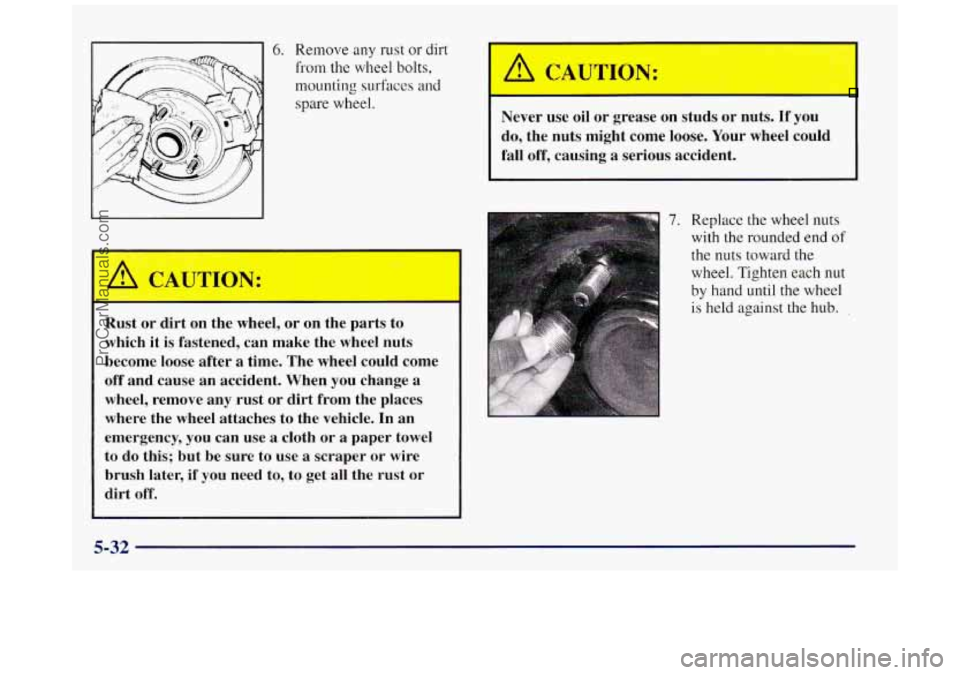
6. Remove any rust or dirt
from the wheel bolts,
mounting surfaces and
spare wheel.
Rust or dirt on the wheel, or on the parts to
which it is fastened, can make the wheel nuts
become loose after
a time. The wheel could come
off and cause an accident. When you change a
wheel, remove any rust or dirt from the places
where the wheel attaches to the vehicle. In an
emergency, you can use
a cloth or a paper towel
to do this; but be sure to use a scraper or wire brush later,
if you need to, to get all the rust or
dirt off.
Never use oil or grease on studs or nuts. If you
do, the nuts might come loose. Your wheel could
fall off, causing a serious accident.
7. Replace the wheel nuts
with the rounded end
of
the nuts toward the
wheel. Tighten each
nut
by hand until the wheel
is held against the hub. ,
5-32
ProCarManuals.com
Page 289 of 422
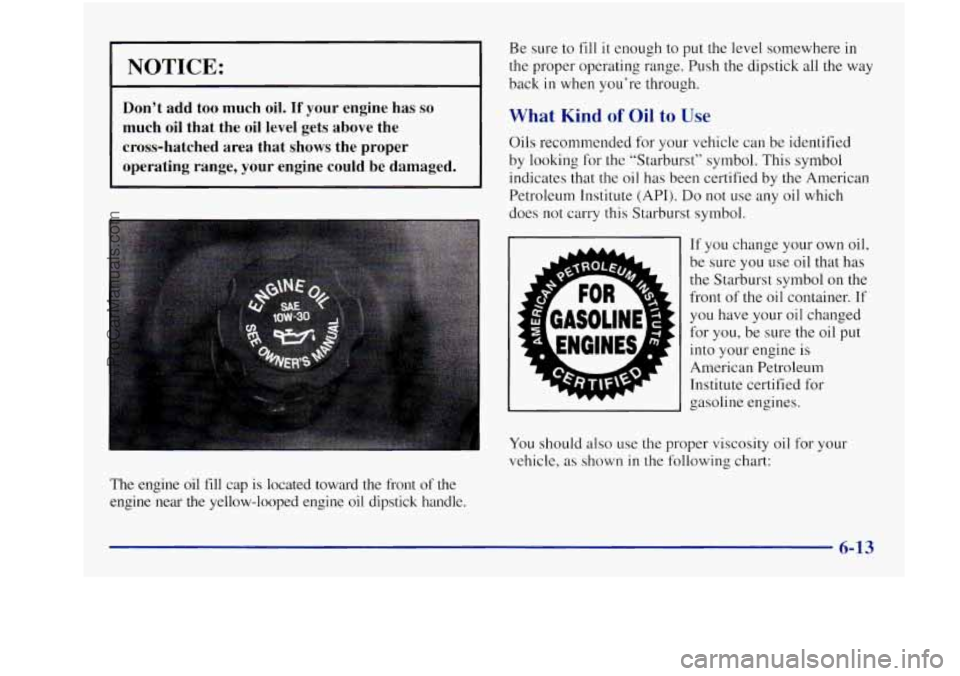
NOTICE:
Don’t add too much oil. If your engine has so
much oil that the oil level gets above the
cross-hatched area that shows the proper
operating range, your engine could
be damaged.
The engine oil fill cap is located toward the front of the
engine near the yellow-looped engine oil dipstick handle. Be
sure to fill
it enough to put the level somewhere in
the proper operating range. Push the dipstick all the way
back
in when you’re through.
What Kind of Oil to Use
Oils recommended for your vehicle can be identified
by looking for the “Starburst” symbol. This symbol
indicates that the oil has been certified by the American
Petroleum Institute (API).
Do not use any oil which
does not carry this Starburst symbol.
If you change your own oil,
be sure you use oil that has
the Starburst symbol on the
front of the oil container.
If
you have your oil changed
for you, be sure the oil put
into your engine is
American Petroleum
Tnstitute certified for
gasoline engines.
You should also use the proper viscosity oil for your
vehicle,
as shown in the following chart:
ProCarManuals.com
Page 290 of 422
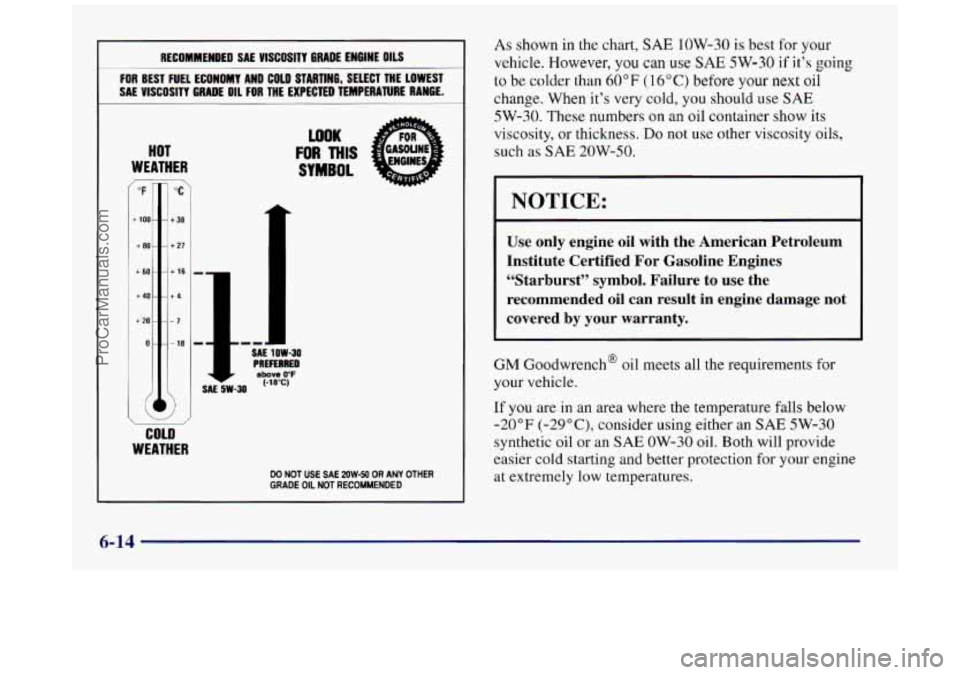
RECOMMENDED SAE VlSCOSlTI GRADE ENGINE OILS
FOR BEST FUEL ECONOMY AND COLD STARTING, SELECT THE LOWEST
SAL VISCOSITY GRADE OIL FOR THE EXPECTED TEMPERATURE RANGE.
HOT
WEATHER
/- ‘ OF ‘C‘
+ 100- - t 38
+80- - +27
+60--+16
+40--+4
+20- --7
0---18
COLD
SAL sw-30
LOOK
FOR MIS
SYMBOL
GEl OW-30 PREFERRED abovo 0°F (-18°C)
WEATHER
DO NOT USE SAE 2OW-50 OR ANY OTHER GRADE OIL NOT RECOMMENDED
As shown in the chart, SAE 1OW-30 is best for your
vehicle. However,
you can use SAE 5W-30 if it’s going
to be colder than 60 OF ( 14 O C) before your next oil
change. When it’s very cold, you should use
SAE
5W-30. These numbers on an oil container show its
viscosity, or thickness.
Do not use other viscosity oils,
such
as SAE 20W-50.
NOTICE:
Use only engine oil with the American Petroleum
Institute Certified For Gasoline Engines
“Starburst” symbol. Failure to use the
recommended oil can result in engine damage not
covered by your warranty.
GM Goodwrench@ oil meets all the requirements for
your vehicle.
If you are in an area where the temperature falls below
-20°F (-29”C), consider using either an SAE 5W-30
synthetic oil or an
SAE OW-30 oil. Both will provide
easier cold starting and better protection for your engine
at extremely low temperatures.
6-14
ProCarManuals.com
Page 291 of 422
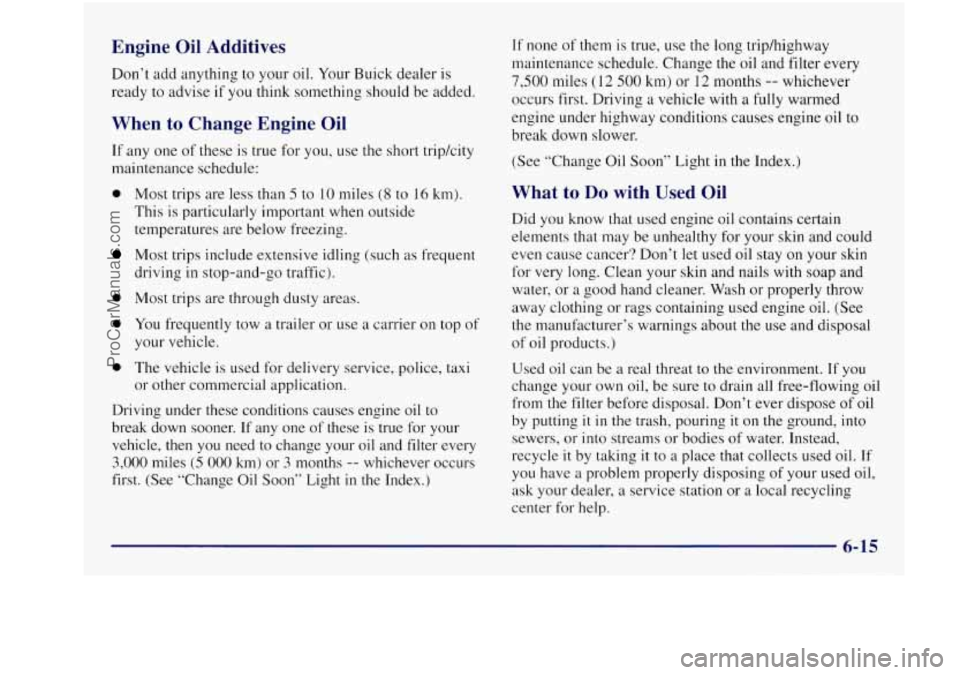
Engine Oil Additives
Don’t add anything to your oil. Your Buick dealer is
ready to advise
if you think something should be added.
When to Change Engine Oil
If any one of these is true for you, use the short tripkity
maintenance schedule:
a
a
a
a
Most trips are less than 5 to 10 miles (8 to 16 km).
This is particularly important when outside
temperatures are below freezing.
Most trips include extensive idling (such as frequent
driving in stop-and-go traffic).
Most trips are through dusty areas.
You frequently tow a trailer or use
a carrier on top of
your vehicle.
The vehicle
is used for delivery service, police, taxi
or other commercial application.
Driving under these conditions causes engine oil to
break down sooner. If any one of these is true for your
vehicle,
then you need to change your oil and filter every
3,000 miles (5 000 km) or 3 months -- whichever occurs
first. (See “Change Oil Soon” Light
in the Index.)
If none of them is true, use the long trip/highway
maintenance schedule. Change the oil and filter every
7,500 miles (12 500 km) or 12 months -- whichever
occurs first. Driving
a vehicle with a fully warmed
engine under highway conditions causes engine
oil to
break down slower.
(See “Change Oil Soon” Light
in the Index.)
What to Do with Used Oil
Did you know that used engine oil contains certain
elements that may be unhealthy for your skin and could
even cause cancer? Don’t let used oil stay on your skin
for very long. Clean your skin and nails with soap and
water, or
a good hand cleaner. Wash or properly throw
away clothing or rags containing used engine oil. (See
the manufacturer’s warnings about the use and disposal
of oil products.)
Used oil can be
a real threat to the environment. If you
change your own oil, be sure to drain all free-flowing oil
from the filter before disposal. Don’t ever dispose of oil
by putting
it in the trash, pouring it on the ground, into
sewers, or into streams or bodies of water. Instead,
recycle it by taking it to
a place that collects used oil. If
you have
a problem properly disposing of your used oil,
ask your dealer, a service station or
a local recycling
center for help.
ProCarManuals.com